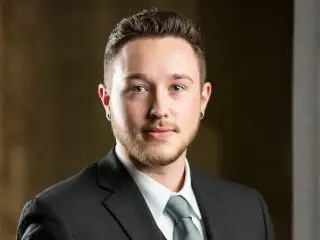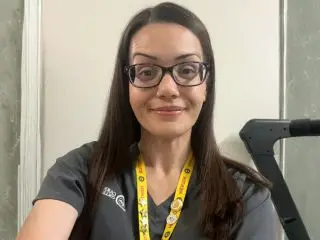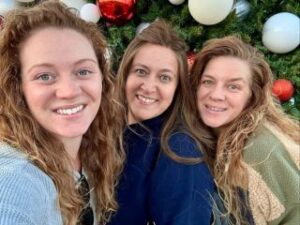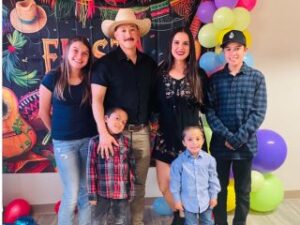Instructor Pamela Payne has lived such a rich and interesting life working with animals that you can’t help but get excited when you hear her talk about her experiences. Those experiences have been both inside and outside the proverbial box and shaped her into the uniquely talented and insightful Lead Veterinary Assisting Program Instructor that she is at Carrington College’s Spokane campus today. Spokane is a city of just over two-hundred thousand people in the easternmost part of Washington State and just 36 miles from Coeur d’Alene, Idaho. Together, their combined statistical areas comprise a population of over seven-hundred thousand people. Students coming to Carrington’s Veterinary Assisting (VA) program benefit from the knowledge Pamm has gained caring for a diverse range of animals for over three decades. She has carefully developed and curated hands-on learning experiences over seventeen years of teaching and nearly a lifetime of being passionate about animals.
Pamm grew up working hard and playing outdoors on her family’s property in woodsy northwestern Oregon. She was the youngest child of parents who moved from Oklahoma to the small town of Buxton, just thirty miles west of Portland and about an hour’s drive from the roaring Pacific Ocean. Her family had a couple of outdoor dogs when she was growing up in the 1960s-70s. They tended to roam around outside, freely and without the same attention that most dogs get today, which would have been typical for that era. The family dog has evolved to be more elevated and protected in their status since then. While that change was happening, the types of pets available to Americans diversified dramatically to include many types of exotic animals—and we aren’t just talking about fluffy hamsters and colorful parrots.
The exotic species that people have today run the gamut and come from all around the world. One significant change in the exotic animal market came about during the ’70s and gained traction during the ’80s and ’90s when reptiles started to come into North America from all around the world. They were imported from Africa, Asia, Australia, South, and Central America. Until then, domestic reptiles were the only option. That is why it would have been difficult, if not nearly impossible, for most people during Pamm’s childhood to imagine that she would grow up to eventually help care for thousands of reptiles and even several large mammals from Africa. She might have already been dreaming about doing something like that, though. Pamm had a passionate interest in animals that started at a very young age and developed into full-blown encyclopedic knowledge by sixth grade. By then she was able to recite facts and figures about animals from around the world with accuracy and enthusiasm that only gained traction and grew over time. That passion still beams from her like a high-beam light to this day.
The enthusiasm that Pamm has for animals goes into everything that she does—including teaching and animal care itself. She is a confessed workaholic who needs very little sleep. That means she doesn’t just teach veterinary assisting to students at Carrington’s Spokane campus, she also keeps her CVT skills active and relevant by working at places like the Northeastern Wildlife lab in Harrison, Idaho where they are currently using woodchucks to study Hepatitis B (they have already studied the C strain). She mostly helps with the cleaning and the treatment. When asked if they were “cute animals,” she acknowledged they were cute but cautioned that she still has to be careful handling them because of their temperament, “they have big teeth and when they’re not happy, they’re not happy.”
When she was still in Oregon, Pamm typically would work at a veterinary clinic while also teaching. True to her workaholic nature, she would take on additional CVT work. Along the way, she had some remarkable opportunities to care for exotic animals. She spent six years working with African animals kept on a 500-acre private sanctuary in Willamina. This included giraffes, rhinos, and snow leopards. The facility was part of the Zoo Association and animals from the Oregon Zoo in Portland were housed there for breeding because it was a less stressful place for them to mate in captivity, which gave them a better chance of conceiving and carrying on their species. She also helped care for approximately 3,000 reptiles for many years in Corvallis, which sits in the central-west part of Oregon. The reptiles were shared with the public through OMSI—Oregon Museum of Science and Industry in Portland. The clinic where she spent the most time working was at Raleigh Hills Veterinary Clinic in Portland. Even though Pamm always had an abiding love of animals, she hadn’t initially walked into Raleigh Hills expecting to work there. She was a licensed young Medical Assistant with a couple of small children and a dog. Her dog needed care from the veterinarian but when she discovered that he needed a CVT, she had an idea. She went back out to her car and retrieved a copy of her resume. When she handed it to him, he looked it over and asked her if she was able to place an IV catheter. She told him she was and got the job. That was the start of her CVT career. She stayed there for twelve years and at times even worked up to 120 hours per week between all her different employers and positions. As Pamm developed more experience with animals, she eventually realized another dream and started caring for her variety of exotic animals on private acreage she purchased in Oregon. She started with a bull snake that her then-husband caught in the—get this—Snake River. She also had hedgehogs, coatimundis, kinkajou, monkeys, and Siberian lynx, which she described as having a personality that is akin to a combination between a dog and a cat. This grew to two-hundred animals that she used educationally at Carrington’s Portland campus and public schools. She also took them to show Boy Scout troops and nursing home communities where the residents found them entertaining and therapeutic. She recalled the special experience of being able to satisfy a centenarian’s final wish. He wanted to meet her alligator SeeMoreTeeth for his 106th birthday so she transported the giant lizard to his rest home. “I took SeeMore in and we spent a couple of hours with him and then the man died the next day,” she said. Whenever her animals died and circumstances allowed for it, Pamm would preserve their fur pelts, hides, skeletons, and teeth for teaching. That way she could use them in the classroom as examples and pass them around to the students to examine. She even once provided her Portland students with wallabies that had recently and unfortunately been killed by dogs to be dissected. She said that she would have been fine being present for the dissection. However, when she considered how her students might feel about having her there, knowing they had been her wallabies, she decided it was best if she left so they could focus on the dissection instead of her feelings. She brought in someone else who was qualified to lead the activity because their learning was her priority even when she had just lost her animals. “I didn’t want them feeling awkward about thinking the dissection was really cool with me standing there,” she said. Pamm recalled another unique learning opportunity she provided for her students with the frankness and common sense of a biologist, “I once had an 18ft pet snake that died. I brought it in and let the students dissect it. It’s like, ‘she’s dead—why not learn from her? I would let someone learn from me if I was dead.'”
After spending her life in Oregon, Pamm was ready for a change starting in 2018 and moved to Northern Idaho. Carrington Spokane didn’t have an opening yet, so she was on a sabbatical from teaching during that time. Then when an opening to teach VA presented itself in 2019 at the Spokane campus, Pamm went for it. Laws in Idaho made it too difficult for her to take her animals with her, so she found most of them new homes. That included her massive collection of reptiles, many of which she donated to Rich Richie the Reptile Man of Oregon who travels around and educates children and adults at public and private venues. She donated many of her mammals to Wildlife Images, a refuge in Grants Pass in Southern Oregon along the historic Siskiyou Trail. Some of her other animals went to the High Desert Museum.
Even though some of these animals, like her kinkajou, were very expensive, the long-term benefits and rewards she gets from donating them outweigh the money she would receive from selling them. They continue to be used educationally and she knows they will get the best vet care. She also can go see them when she visits her home state. It was important for Pamm to keep her connections with her animals alive. She said, “If I want to go see them, I can go see them. I know they are going to get everything that they need—not just be somebody’s pet because they think they are cool. They are doing what I got them for, which is education.” Since starting in Spokane, Pamm has been every bit as dedicated there as she was to her students in Portland—and then some. Last year, Pamm went the extra mile when she discovered that one of her most enthusiastic and engaged Veterinary Assisting (VA) students had no option but to arrive on campus at 4 am and wait for several hours alone in the cold and dark each morning for a class to start. Pamm was concerned about her wellbeing and so she started showing up at 4 am every day so she could let her into the building where she would be safe and warm. She also directed her toward a work-study position. When that student expressed interest in working with exotic animals, Pamm found her an externship that treats them, including many injured wildlife from the region. Now that student has graduated and is working there full-time with great prospects for her future. She helps prepare her students by being realistic with them about what those conditions are going to be like on the job for a VA. “I don’t sugarcoat it—it’s a tough job. You have to ask yourself hard questions like if you could euthanize your best friend’s dog. That is something that people have to think about. And then it is very physical. 85% of the time you are standing on your feet. You also must be able to lift 35 pounds… and you have to like cats as much as dogs.” she said.
If realistic could be one of the adjectives to describe Pamm’s teaching style, so could creative. She pulls together household and kitchen products to create abscesses, vomit, and feces to help prepare her students for some of the less desirable aspects of their job and makes the experience fun. She mixes up substances like fish, oil, cooking sauces, cat food, and Spam. Then she squeezes that mixture inside latex gloves that she glues shut. Students puncture and extract the contents of the abscesses using tools in the classroom. The fake feces and vomit have items hidden inside them for the students to locate. They might do something similar on the job while looking for evidence of parasitic infections or foreign objects that animals have digested.
By teaching relevant material in such an original and hands-on manner, Pamm is not only helping her students gain experience, but she is also giving them opportunities to build confidence that they can carry into their externships, VA careers, and lives beyond Carrington College. She hopes that some will even return to the classroom to carry on the tradition of instructing students someday. If they do, they will walk in with the advantage of learning from a passionate and innovative instructor who showed them how to engage, motivate, and prepare students for their careers in veterinary assisting through relevant subject matter presented in innovative and engaging ways. It doesn’t get better than that.



